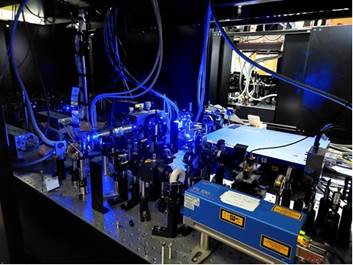Ministry of Science & Technology
Towards more precise atomic clocks useful for navigation, Telecommunication & Aviation
प्रविष्टि तिथि:
22 OCT 2024 3:43PM by PIB Delhi
A team of experimentalists working with cold Rydberg atoms have used Quantum magnetometry to help the atomic clocks and magnetometers used for precise time keeping in navigation, telecommunication and aviation, achieve higher precision and make them additionally robust.
A Rydberg atom is an excited atom with one or more electrons that have a very high principal quantum number. This state of excitation is measured with a spectroscopic method called the Electromagnetically Induced Transparency (EIT).
Researchers at the Raman Research Institute (RRI) have leveraged the Doppler effect to their advantage and achieved a ten times enhanced response to the magnetic field while performing quantum magnetometry (phenomenon exploiting the quantum nature of light and atoms for precision measurement of magnetic fields) on thermal rubidium atoms using Rydberg Electromagnetically Induced Transparency (EIT) in a room temperature-based environment.
Electromagnetically Induced Transparency (EIT) is a fascinating phenomenon which makes an opaque medium transparent, can slow down light pulses to crawling speeds and even trap light inside atomic media. EIT has led to a myriad important applications in precise atomic clocks, atomic magnetometers and quantum computation. EIT generally occurs in a three-level atomic system involving two atomic transitions addressed by a weak probe laser beam and a strong coupling laser beam.
Scientifically, interference occurs when a wave is able to travel between two points via multiple paths, either resulting in their enhancement or cancellation. On similar lines, an atom can transition between multiple quantized energy levels by different routes that can interfere. This determines the amount of light an atom absorbs.
Similar to interference of light, where constructive interference gives bright fringes and destructive interference gives dark fringes, the probabilities of atomic transitions between these energy levels can also interfere destructively, known as quantum interference. It can result in atoms in a dark state to not absorb the probe light and thereby render the atomic medium transparent. This phenomenon is called Electromagnetically Induced Transparency (EIT).
Deploying Rydberg EIT, the researchers detected atoms in their highly excited (Rydberg) states. Rydberg Electromagnetically Induced Transparency has a Rydberg state as one of the energy levels involved in the EIT process. Rydberg EIT signals were used to measure the response of the Rydberg atoms to the external magnetic field.
“When the Rydberg EIT was observed in an unconventional configuration of the probe and the coupling beam, where the Doppler shift was not compensated, an enhanced response to the magnetic field was observed. It is the Doppler shift which causes a larger response of the Rydberg EIT signal to an externally applied magnetic field,” said Dr. Sanjukta Roy, Head of Quantum Optics with Rydberg Atoms Lab (QuORAL) at RRI, an autonomous institute of the Department of Science and Technology (DST).
Generally, Doppler shift is perceived as the change in frequency of a wave by a moving observer. When a laser beam flashes on atoms, their thermal motion leads to a Doppler shift – an atom moving towards the laser beam sees a higher frequency, whereas one moving away sees a lower frequency. This effect is generally assumed to be detrimental to sensing.
The experimentalists, in the paper published recently in the New Journal of Physics, have demonstrated and successfully harnessed the quantum effects at room temperature by effectively using this Doppler effect to their advantage. They have also explained their experimental observations using theoretical modeling and simulations in collaboration with Dr. Shovan Dutta, Theoretical Physics group, RRI.
“Magnetic fields alter the energy levels. In its presence, the energy levels get shifted by different amounts, producing multiple transmission peaks whose separation can be used to measure the magnetic field,” said Shovan Kanti Barik, a PhD student at RRI and lead author of the paper titled ‘Doppler-Enhanced Quantum Magnetometry with Thermal Rydberg atoms’.
Cryogenically-cooled superconducting devices are useful for sensing ultra-weak magnetic fields.
“But our experiment in room-temperature vapor-cell can be conveniently deployed for various practical applications. This was made possible due to the simplified experimental system and non-requirement of atom cooling or ultra-high vacuum. This implies that our results have promising applications for detecting weak magnetic fields in a convenient-to-use room-temperature setup,” Roy added.
Such Doppler-enhanced quantum Magnetometry offers a wide variety of applications ranging from geophysics to the detection of brain activity and mineralization to space explorations and archaeology.

Experimental set-up used for the observation of Doppler-Enhanced Quantum magnetometry with Rydberg atoms
***
NKR/KS/AG
(रिलीज़ आईडी: 2067034)
आगंतुक पटल : 1774